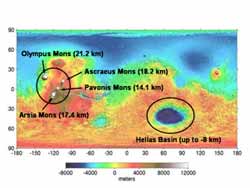The highs and lows of Martian Water Vapour

Measurements of water vapour in the atmosphere of Mars by the PFS (Planetary Fourier Spectrometer) and OMEGA (Observatoire pour la Minéralogie, l’Eau, les Glaces, et l’Activité) instruments, both onboard Mars Express, give us a clear view on the seasonal behaviour of water vapour in the atmosphere of Mars. The study shows irregularities in the behaviour of water vapour, different from the global trend on Mars, in the atmosphere surrounding the Big Volcanoes and the Hellas Basin, which are respectively the highest and lowest regions on Mars.
There have been regular measurements of the behaviour of water vapour during the Martian year since the 1970s, but the complementary characteristics of these two instruments allow a comprehensive analysis of the Martian water cycle with unprecedented detail.
“For most of the year, the atmosphere on the summit of the big volcanoes is enriched in water vapour – the ratio of water vapour is much higher compared to the surrounding areas. This can be explained by upslope currents activated by the extreme topography of the region that bring up a lot of material, water vapour included, from the bottom to the summit,” said Luca Maltagliati, a scientist at the Max Planck Institute for Solar System Research.
In the Hellas Basin region, the observations also showed a peculiar seasonal behaviour. While the north seems to present the same quantity of water vapour through the Martian year, the interior of the basin seems to be depleted of it in some seasons, especially if compared to the south region.
The causes for this are still being investigated but it is believed that, in this case, local circulation of the atmosphere plays an important role. In fact, Hellas itself is known to have an important part in driving the circulation of the whole Southern hemisphere of Mars. The presence of surface ice was also observed during local winter.
These results mark the importance of local influence on the global water cycle.
Media Contact
All latest news from the category: Physics and Astronomy
This area deals with the fundamental laws and building blocks of nature and how they interact, the properties and the behavior of matter, and research into space and time and their structures.
innovations-report provides in-depth reports and articles on subjects such as astrophysics, laser technologies, nuclear, quantum, particle and solid-state physics, nanotechnologies, planetary research and findings (Mars, Venus) and developments related to the Hubble Telescope.
Newest articles

Bringing bio-inspired robots to life
Nebraska researcher Eric Markvicka gets NSF CAREER Award to pursue manufacture of novel materials for soft robotics and stretchable electronics. Engineers are increasingly eager to develop robots that mimic the…

Bella moths use poison to attract mates
Scientists are closer to finding out how. Pyrrolizidine alkaloids are as bitter and toxic as they are hard to pronounce. They’re produced by several different types of plants and are…

AI tool creates ‘synthetic’ images of cells
…for enhanced microscopy analysis. Observing individual cells through microscopes can reveal a range of important cell biological phenomena that frequently play a role in human diseases, but the process of…





















